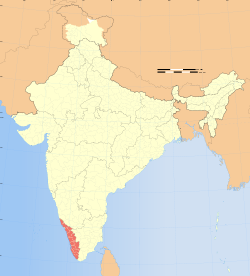Naduvazhi

Naduvazhi (Malayalam:നാടുവാഴി) refers to landlords, chieftains and descendants of royal households in the region now known as Kerala, India.
Function
Prior to the British reorganisation of the area now known as Kerala, it was divided into around ten feudal states. Each of these was governed by a rajah (king) and was subdivided into organisational units known as nads. In turn, the nads were divided into dēsams, which anthropologist Kathleen Gough considers to be villages.[1] However, the early 20th-century historian Kavalam Panikkar states that the dēsams were themselves divided into amsas, and that these were the villages. He believes that generally only the amsas survived the reorganisation.[2]
The person who governed the nad was known as the naduvazhi. It was an inherited role, originally bestowed by a king, and of a lower ritual rank than the royal lineages. Although Nair families, they generally used the title of Samantan and were treated as vassals. However, some naduvazhi were feudatory chiefs, former kings whose territory had been taken over by, for example, the Zamorins of Calicut. In these instances, although they were obeisant to the rajah they held a higher ritual rank than the Zamorin as a consequence of their longer history of government; they also had more power than the vassal chiefs. The naduvazhi families each saw themselves as a distinct caste in the same manner as did the rajahs; they did not recognise other naduvazhi families as being equal to them.[1] The naduvazhi maintained criminal and civil order and could demand military service from all Nairs below him. There was usually a permanent force of between 500 and 1000 men available and these were called upon by the rajah when required. All fighting was usually suspended during the monsoon period of May to September, when movement around the country was almost impossible. Roads did not exist, nor wheeled vehicles or pack animals, until after 1766.[2][3]
Titles
Kerala Naduvazhi titles:
Sometimes the naduvazhi was given the additional title of Prabhu by the Raja, if he had a higher than average number of Nairs under his command. He was called Ayyayira Prabhu, if he had 5,000 Nairs, and if he had 10,000 or more, then he was called a Pathinayira Prabhu.[5]
See also
References
- 1 2 Gough, E. Kathleen (1961). "Nayars: Central Kerala". In Schneider, David Murray; Gough, E. Kathleen. Matrilineal Kinship. University of California Press. pp. 307–308. ISBN 978-0-520-02529-5. Retrieved 2011-11-07.
- 1 2 Panikkar, Kavalam Madhavan (July–December 1918). "Some Aspects of നായർ Life". Journal of the Royal Anthropological Institute. 48: 257–258. Retrieved 2011-11-07.
- ↑ Gough, E. Kathleen (1961). "Nayars: Central Kerala". In Schneider, David Murray; Gough, E. Kathleen. Matrilineal Kinship. University of California Press. pp. 302–303. ISBN 978-0-520-02529-5. Retrieved 2011-11-07.
- ↑ History of Thiruvananthapuram. General Books. 2010. pp. 132–. ISBN 978-1-1581-8846-8. Retrieved 10 June 2011.
- ↑ T. K. Gopal Panikkar (31 August 2008). Malabar and Its Folk. Hamlin Press. pp. 111–. ISBN 978-1-4437-1802-8. Retrieved 10 June 2011.